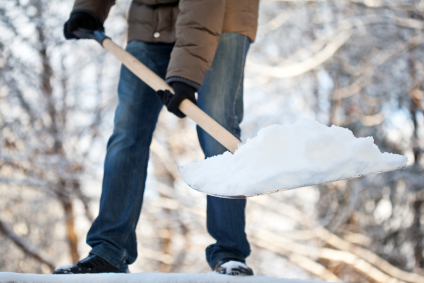If it hasn’t already found its way to your home, it no doubt will. Winter is here, and if you live in a part of the country where snow and ice are likely — an increasingly larger swath of the country these days — then you’ll be shoveling, salting, deicing, scraping and blowing or throwing snow on your property soon. Here are 5 tips to help you prepare for whatever winter sends your way.
No. 1: Upgrade your snow shovel
There are a surprising number of snow shovel designs — including one that looks like a unicycle! Basic rules, however, apply. Don’t buy a snow shovel with a wide blade if your idea of a workout is watching a football game. A small scoop may lengthen snow removal sessions, but it will help save your back and keep your cardiologist happy. Choose a shovel with a securely fastened, comfortable D-shaped grip. Some models come with an auxiliary grip that reduces the need for you to bend your back, which can cause back strain. Look for a sturdy steel or wooden handle. The blade’s edge should be reinforced with galvanized steel.
Plow-style shovels or snow pushers, some of which come with wheels, allow users to push snow out of the way instead of lifting and tossing it. These are ideal for long, straight runs and for clearing decks. With blades up to 3 feet wide, however, strength and endurance are required.
No. 2: Buy a good windshield scraper
Treat yourself to the sturdiest scraper you can find. Cheap ones break when you need them most. Opt for one that includes a handle that’s at least 2 feet long and that has a brush or squeegee on one end. If your vehicle is large, get one that extends to 3 feet. The Thor ice scraper includes a squeegee and double scraper that removes ice on both the push and pull strokes. The stainless steel handle extends to 3 feet and includes an extra grip for improved leverage.
No. 3: Stock up on ice melter
The best ice melters contain magnesium chloride or calcium chloride. They melt ice at temperatures near 0 degrees Fahrenheit and are generally less harmful to the environment. Rock salt is slightly less expensive, but it melts ice more slowly, ceases to be effective below 20 degrees Fahrenheit, and may damage concrete, lawns and plantings. It may even be harmful to animals. That said, not all “green” melts are safe around pets (and wild animals), so look for a salt-free ice melter or a product that is made from magnesium chloride. Typically, such products will be labeled “pet friendly.” Sand or kitty litter, although not an ice melter, is useful for improving traction on icy surfaces too.
No. 4: Invest in a roof rake
If you’re plagued with ice dams, despite keeping your attic insulated and ventilated, consider a snow rake. Ice dams often form on roofs, such as a cathedral ceiling, under which there is no attic. Use the rake to remove snow buildup from the lower 3 or 4 feet of your roof, so that melting snow can drain off before ice dams have a chance to build up. Snow rakes are typically fitted with a 2-foot-wide blade that’s perpendicular to the handle. The handle may be telescoping or extendable with snap-on sections. Better models have wheels that protect roof shingles as you push and pull the rake. Handle lengths range from 15 to 22 feet. An innovative “rake” design that doesn’t fit the mold is called the Avalanche. Its blade cuts through snow accumulation instead of pulling or pushing it. As chunks of snow break loose, they slide to the ground on the plastic sheeting attached to the bottom of the blade.
If you’re too late in preventing an ice dam, and it’s beginning to back up and leak inside your home, it’s usually best to call a pro. Some homeowners, however, have had success tossing a pair of calcium chloride-filled pantyhose across the dam at 6-foot intervals. Ice melt tablets formulated for roofs may also be effective, depending upon temperature and your ability to safely place them near the ice dam.
No. 5: Consider a snow blower or thrower
Snow throwers and blowers are an attractive option if you live where average annual snowfalls reach 3 feet or if you are physically impaired. Otherwise, most people get by without them. The initial cost, maintenance, fuel and storage space required for such units is simply not worth it. Choose a snow thrower for small- and medium-size clearing, and a snow blower for larger areas. Snow throwers, also called single-stage snow throwers, are smaller both in width and vertical intake. They remove and throw the snow in one continuous motion. Snow blowers, also called two-stage snow blowers, scoop up snow with an auger that feeds it to an impeller. The impeller allows snow blowers to throw snow much farther than snow throwers.
For lighter-duty snow removal, consider an electric snow shovel or an electric snow thrower. The former are typically able to handle 4-inch depths; the latter can handle 10-inch depths. The nice thing about these machines is that maintenance is significantly reduced. Electric snow throwers are available both corded and cordless.

